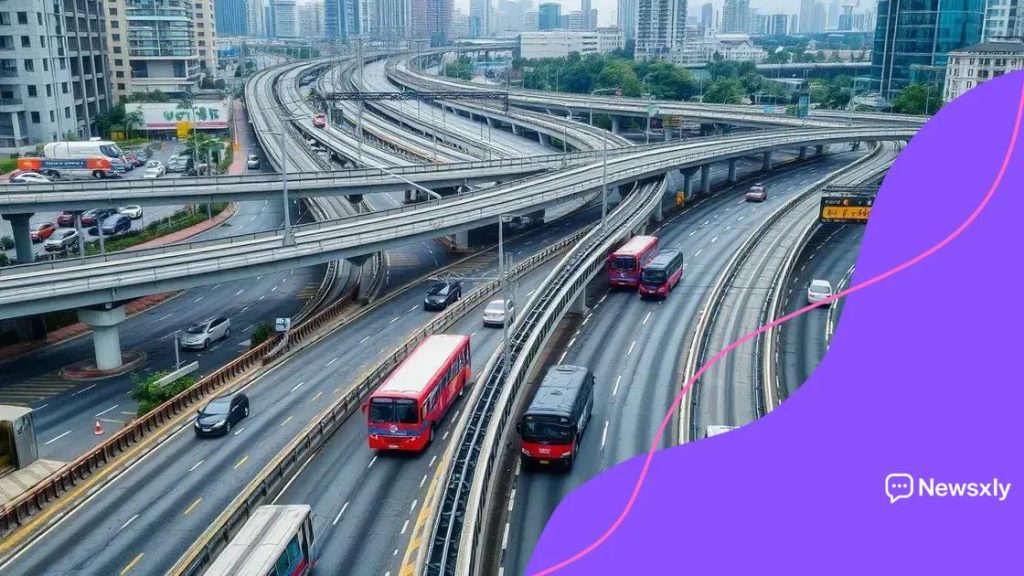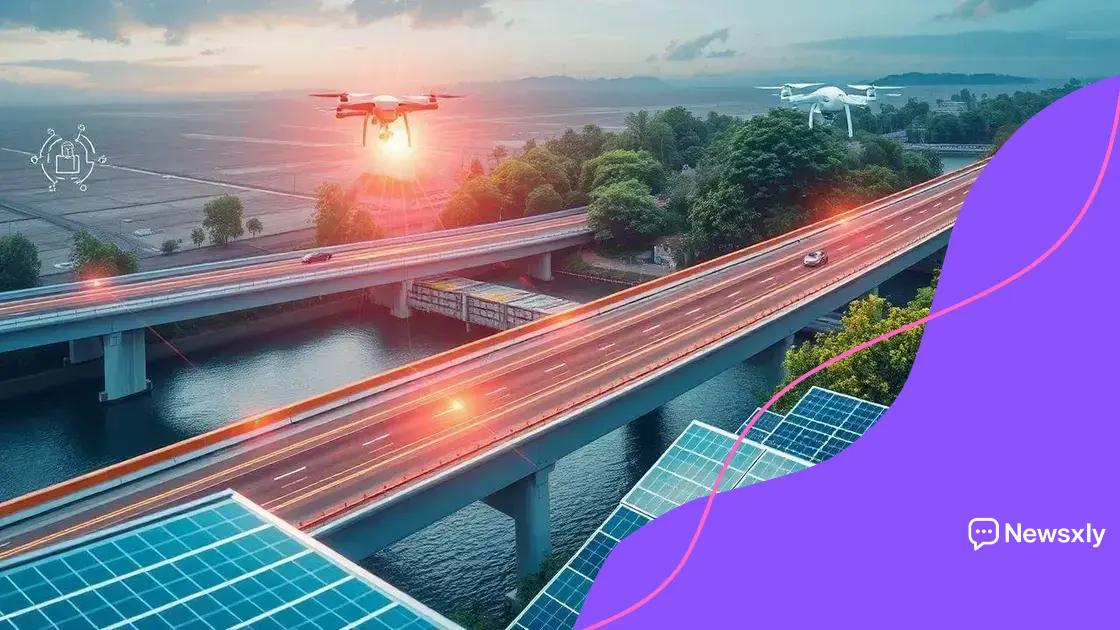The state of infrastructure in the US: challenges and solutions

The state of infrastructure in the US faces major challenges such as aging systems and funding shortages, but future trends focus on sustainability, technology integration, and community involvement to enhance safety and efficiency.
The state of infrastructure in the US is a pressing issue that affects everyone, from daily commuters to businesses relying on efficient logistics. How well do you think our roads, bridges, and public transport systems are holding up?
Current status of US infrastructure
The current status of US infrastructure reveals a mix of critical challenges and opportunities for improvement. From crumbling roads to outdated public transport, the infrastructure system is in need of major attention.
Major Infrastructure Areas
Several key areas highlight the state of our infrastructure.
- Roads and Highways: Many roads are in disrepair, leading to safety hazards and longer travel times.
- Bridges: A significant number of bridges are rated as structurally deficient, posing serious risks.
- Public Transit: In cities, public transportation often struggles with outdated systems and overcrowding.
Beyond these concerns, there are opportunities to enhance our infrastructure. For example, investing in technology can lead to smarter traffic management systems, which could improve road efficiency dramatically.
We also see states experimenting with innovative solutions, such as renewable energy resources for public facilities. By focusing on sustainability and modernization, the US can shift towards a more resilient infrastructure.
Federal and State Initiatives
Various federal and state initiatives are addressing these pressing challenges. For instance, funding programs aim to repair and upgrade critical infrastructure. Additionally, there is a push for bipartisan support to enhance infrastructure spending, which could lead to job creation and economic growth.
Engaging the community is also vital. Citizens’ voices play a crucial role in shaping infrastructure policies. Public forums and discussions can help gather insights and promote transparency in decision-making.
With all these efforts, the current push towards better infrastructure represents a pivotal moment in US history. With the right investments and strategies, we have the chance to redefine how we navigate our spaces.
Key challenges in infrastructure maintenance
The key challenges in infrastructure maintenance are significant and multifaceted. As our infrastructure ages, cities face increasing difficulties in keeping roads, bridges, and public transport systems safe and functional.
Funding Shortages
One of the main barriers is insufficient funding. Many states and local governments struggle with budget constraints. This leads to delays in essential repairs and upgrades.
- Budget limitations: Falling tax revenues during economic downturns can hamper maintenance efforts.
- High costs: Infrastructure projects often come with significant expenses that exceed planned budgets.
- Shift in priorities: Political changes can lead to a focus on new projects instead of maintaining existing systems.
Another challenge is the aging workforce in construction and maintenance sectors. Experienced workers are retiring, and the system faces difficulty attracting new talent. This skill gap can delay response times for urgent repairs.
Technological issues also play a role. While new technologies can enhance maintenance, many agencies lack the resources to implement them effectively. From smart sensors to predictive analytics, there’s potential for improvement that remains untapped.
Natural Disasters and Climate Challenges
Natural disasters pose an increasing threat to infrastructure. Floods, hurricanes, and earthquakes can inflict severe damage, leading to costly repairs and prolonged outages.
Climate change further exacerbates these challenges. Rising sea levels and extreme weather conditions require adaptive strategies. Communities must now invest in resilience to protect their infrastructure against these unpredictable elements.
Collaboration between various stakeholders is essential to address these hurdles. Local governments, state agencies, and federal support can work together to identify solutions, set priorities, and allocate resources more effectively.
Innovative solutions for infrastructure improvement

Innovative solutions for infrastructure improvement are crucial for addressing the challenges facing the US today. By leveraging new technologies and creative approaches, we can enhance the safety and efficiency of our infrastructure.
Smart Technology Integration
One promising avenue is the integration of smart technologies. Sensors embedded in roads can monitor traffic flow and detect issues in real-time.
- Traffic management: Smart traffic lights adjust timing based on vehicle flow, reducing congestion.
- Predictive maintenance: Sensors alert authorities to structural weaknesses before they become serious problems.
- Data collection: Gathering information helps city planners make informed decisions about upgrades and repairs.
Moreover, the use of drone technology is proving beneficial in inspecting hard-to-reach areas of infrastructure. Drones can quickly assess the condition of bridges, highways, and other essential structures, providing valuable data without extensive manual labor.
Sustainable Practices
Another vital component is adopting sustainable practices. Green infrastructure solutions, such as permeable pavements and green roofs, help manage stormwater and reduce urban heat.
Additionally, investing in renewable energy sources for infrastructure, like solar panels on public buildings, can reduce costs and environmental impact. These solutions not only improve infrastructure but also contribute to a healthier planet.
Collaboration between various sectors, including public agencies, private companies, and community organizations, is essential for implementing these innovative solutions. Working together, we can ensure that improvements are effective and meet the needs of all citizens.
Impact of infrastructure on economy and society
The impact of infrastructure on economy and society is profound and far-reaching. Well-developed infrastructure supports economic growth by facilitating trade, improving access to services, and enhancing overall quality of life.
Economic Growth
For businesses, reliable infrastructure such as roads, railways, and airports is crucial. It enables efficient transportation of goods, which lowers costs and boosts profits. When infrastructure is robust, it attracts investments and encourages new businesses to emerge.
- Job Creation: Improved infrastructure projects lead to new jobs in construction and related fields.
- Increased Productivity: Businesses can operate more effectively without delays caused by poor infrastructure.
- Enhanced Competitiveness: Regions with strong infrastructure are often more appealing for corporations.
Additionally, good infrastructure enhances connectivity, not just locally but also globally. Regions with easy access to major highways or ports often see an influx of trade and tourism.
Social Benefits
Infrastructure also significantly impacts society. Facilities such as schools, hospitals, and public transportation services improve the wellbeing of communities. Access to quality roads and public transit enables people to reach jobs, education, and health services with ease.
Health and Safety: Reliable water supply and sewage systems protect public health. Similarly, well-maintained roads reduce accidents and save lives.
Moreover, infrastructure investment can lead to improved social equity. When marginalized communities have access to better infrastructure, they can participate more fully in the economy and society.
Looking ahead, it’s clear that the state of our infrastructure directly affects our daily lives and long-term prospects. Investments in infrastructure are not just good for the economy; they are essential for building a more equitable and resilient society.
Future trends in US infrastructure development
The future trends in US infrastructure development are becoming increasingly focused on sustainability, technology, and resilience. As the demand for efficient and safe infrastructure grows, innovative methods and approaches will shape how we build and maintain our systems.
Sustainable Practices
One significant trend is the shift towards sustainable infrastructure. Cities are now prioritizing environmentally friendly materials and energy-efficient designs. This not only helps reduce the carbon footprint but also saves on long-term costs. Examples include:
- Green roofs: These help reduce heat and manage stormwater effectively.
- Recycled materials: Using materials salvaged from old structures minimizes waste.
- Renewable energy sources: Incorporating solar panels into infrastructure reduces reliance on non-renewable resources.
By focusing on sustainability, infrastructure not only meets current needs but also preserves resources for future generations.
Technological Innovations
Another key trend is the integration of advanced technologies. Smart technology is reshaping how infrastructure is developed and utilized. Implementing sensors and IoT devices can lead to:
- Real-time monitoring: Detecting issues before they escalate into major problems.
- Data-driven decision-making: Using analytics to optimize maintenance schedules and resource allocation.
- Enhanced user experience: Providing information about traffic conditions and public transport in real-time.
This technology-driven approach will enhance the efficiency and longevity of infrastructure systems.
Furthermore, addressing climate change is critical in future infrastructure plans. Resilient designs account for extreme weather patterns, ensuring that structures can withstand environmental challenges. This involves enhancing flood defenses and using materials that can adapt to changing conditions.
Collaboration between federal, state, and local governments will be essential to support these trends. As policies evolve, so too will funding priorities and community engagement initiatives. Together, these elements will define the future of infrastructure in the US.
FAQ – Frequently Asked Questions about US Infrastructure
What role does technology play in modern infrastructure development?
Technology enhances infrastructure with smart systems that improve efficiency, safety, and maintenance.
How can sustainable practices impact infrastructure?
Sustainable practices reduce environmental impact, lower operating costs, and improve long-term resilience.
Why is community involvement important in infrastructure projects?
Community input ensures that infrastructure meets local needs and priorities, leading to better outcomes.
What are some challenges facing US infrastructure today?
Challenges include aging systems, funding shortages, and the impacts of climate change on infrastructure resilience.





